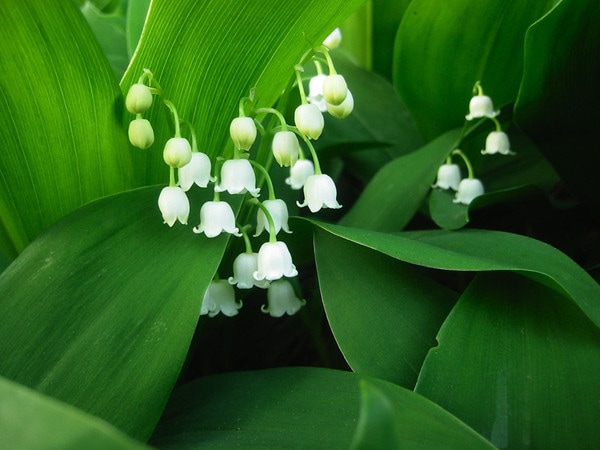|
Lily of the Valley's scent cannot be captured to make perfumes. If someone try to sell you a Lily of the valley perfume, know that it may not be natural.
Lily of the valley is found across Europe, Asia and in North America, in dry woodland, usually on alkaline soils and sometimes in the crevices or grikes of limestone pavement. In common with many plants that are impossible to eradicate once they've made themselves at home – Reginald Farrer calls it "the worst of all delicious weeds" – it is notoriously difficult to establish. Just below the surface of the soil its stems eke out a living from the leaf litter and radiate outwards, producing tufted roots and aerial shoots at their nodes. This colonising habit, essential in its native habitat as it quests for new food sources, is also the reason for the patchy growth in a garden setting.
If you leave it to wander lily of the valley should flower happily, the stem extending as the round green buds open and allow the bells to hang gracefully. The lily of the valley is a flower that is most often viewed as a symbol of rebirth and humility. It can be used to symbolize chastity, purity, sweetness, and motherhood, too. Lily of the valley flowers are thought to bring luck in love but can also symbolize a return of happiness. |
Lily of the Valley
|
- Home
- Introduction
- Choose your Plan
-
Choose your Plants
- Alecost
- Anchusa
- Angelica
- Balkan Sage
- Balm
- Basil Sweet & Bush
- Bergamot
- Borage
- Calaminth
- Camphor Plant
- Caraway
- Catmint
- Chamomile
- Chervil
- Chives
- Clary
- Comfrey
- Coriander
- Dill
- Elecampane
- Fennel
- Fennel Florence
- Feverfew
- Garlic
- Germander
- Giant Catmint
- Herb Patience
- Horehound
- Hyssop
- Lad's Love
- Lady's Maid
- Lavender
- Lily of the Valley
- Lovage
- Lungwort
- Mace
- Mallow
- Marigold
- Marjoram
- Melilot
- Mints
- Old Lady
- Parsley
- Pennyroyal
- Rose
- Rosemary
- Rue
- Sage
- Salvia Virgata Nemorosa
- Santolina Chamaecyparissus
- Savory
- Sorrel
- Sweet Cicely
- Tansy
- Tarragon
- Thyme
- Vervain
- Woad
- Wormwood
- Workshops
- Q & A
- Blog
- Contact
- Home
- Introduction
- Choose your Plan
-
Choose your Plants
- Alecost
- Anchusa
- Angelica
- Balkan Sage
- Balm
- Basil Sweet & Bush
- Bergamot
- Borage
- Calaminth
- Camphor Plant
- Caraway
- Catmint
- Chamomile
- Chervil
- Chives
- Clary
- Comfrey
- Coriander
- Dill
- Elecampane
- Fennel
- Fennel Florence
- Feverfew
- Garlic
- Germander
- Giant Catmint
- Herb Patience
- Horehound
- Hyssop
- Lad's Love
- Lady's Maid
- Lavender
- Lily of the Valley
- Lovage
- Lungwort
- Mace
- Mallow
- Marigold
- Marjoram
- Melilot
- Mints
- Old Lady
- Parsley
- Pennyroyal
- Rose
- Rosemary
- Rue
- Sage
- Salvia Virgata Nemorosa
- Santolina Chamaecyparissus
- Savory
- Sorrel
- Sweet Cicely
- Tansy
- Tarragon
- Thyme
- Vervain
- Woad
- Wormwood
- Workshops
- Q & A
- Blog
- Contact


